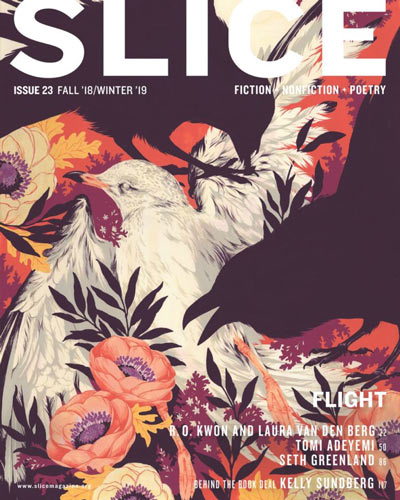SLICE – Fall 2018/Winter 2019
The cover of SLICE Issue 23 is a confluence of great design choices, from the gorgeous, slightly menacing artwork of Teagan White to the title itself, which sits, top-trimmed, like a visual onomatopoeia. The cover is glossy, the text is bright and easy to read, and the issue is slim but still substantial. The magazine exudes a contagious confidence, a sense that this, here, is everything a lit mag should be.
The cover of SLICE Issue 23 is a confluence of great design choices, from the gorgeous, slightly menacing artwork of Teagan White to the title itself, which sits, top-trimmed, like a visual onomatopoeia. The cover is glossy, the text is bright and easy to read, and the issue is slim but still substantial. The magazine exudes a contagious confidence, a sense that this, here, is everything a lit mag should be.
The magazine, which was founded by editors who were tired of seeing fresh perspectives cast aside, champions emerging writers, highlighting them in their own section and offering interviews with writers, agents, and editors that pull back the curtain a bit. In one such feature, Kelly Sundberg discusses her propulsion from small-town Idaho into the publishing world after her essay about domestic abuse went viral. Also involved in the conversation are Joy Tutela, her agent, and Gail Winston, her editor. The discussion focuses on Sundberg’s personal and creative journey, as well as the collaborative process, the way connections are formed, and the work of choosing a title. Three other compelling author interviews feature R.O. Kwon, Laura van den Berg, Tomi Adeyemi, and Seth Greenland.
The powerhouse of the issue, a piece by Tonya Canada titled “This Is Where We Are,” is the first chapter of what she calls her “dad-damage memoir.” The piece, which is split into many small scenes, begins at six a.m. but travels backwards through time as well, painting a detailed and moving portrait of a man who is complex, broken even in his strength, and whose willingness to harm others stems from an uncompromising personal code untouched by empathy and fueled by self-interest. At eighty-one, Canada’s father finds fault in others with ease, yet minimizes his own weaknesses, his failings. She is nonetheless drawn to him, having reconnected after years of keeping her distance. The piece, so well-rendered and compelling, is immediately relatable to anyone unable to cut ties, no matter how complicated and traumatizing family can be.
In “Subvocal (Challenger),” Mark Neely captures his teenage years, framing the period with pop cultural markers and political props, admitting to cruelty and pleasure in pain, and recalling a day spent smoking in an abandoned mansion, “dust floating in the sunlight / like our nebulous desires,” always hurtling through, and to, an unknown dark.
“What Makes the Actual World Actual Is Simply that It Is Our World” by Eleanor Stanford is a need for flight disguised as want, the story of an affair, of unserious plans and unintended but potent meanings. “Instead, you tell me about division / of semantic labor,” Stanford writes. “How we can say things, and not know / exactly what we mean.”
In “Somebody Loves Me,” Kristina Gorcheva-Newberry tells the story of Katya, a woman who always cries after sex with her married lover because it is so good, but also because of their precarious relationship; he is not willing to lose his sons. Katya’s world, so full of compromise, shakes loose with the arrival of her half-brother, Gevork, whose existence she’d only recently discovered. Her brother has taken on their father’s life work, searching for Noah’s Ark, a fact that her lover, David, derides. Caught between David’s shallowness and the intensity of discovering a sibling she’d never known, Katya must begin to make choices for herself, regardless of the cost. She’s already invested too much in other people. “And then she imagined none of it,” Gorcheva-Newberry writes, “just a cab and a road—nowhere, for miles and miles—a curve, a bump, a stretch.”
“Popsicle Man” by Siwatu Moore is an altogether different type of story. Set in crumbling Detroit, the piece centers around Mike, who plays pickup hockey with friends in an abandoned book depository. A burst pipe has created a perfect playing surface for the men in winter, but their spot is put at risk when they discover the body of a man half frozen to a wall, his red sneakers kicked out like a “break-dancer caught in mid-backspin.” Mike’s life is already complicated: he lives with his sister, makes too little selling phones to afford his own place, and his best friend, once an EMT, is an unemployed addict filled with get-rich schemes. Mike knows they’re all treading water. The question is whether there’s a shore to swim to.
SLICE is that refuge, that source of steady footing, and reading it has been an absolute pleasure. This issue is a gift, a beautifully assembled work of art that honors its contributors, respects its readers, and encourages those on the sidelines to get into the game. This is the space past the caution tape, the magazine that cuts through “Do Not Enter” and says, “Welcome Home.” The only thing left is to open the door.
[slicemagazine.org]





